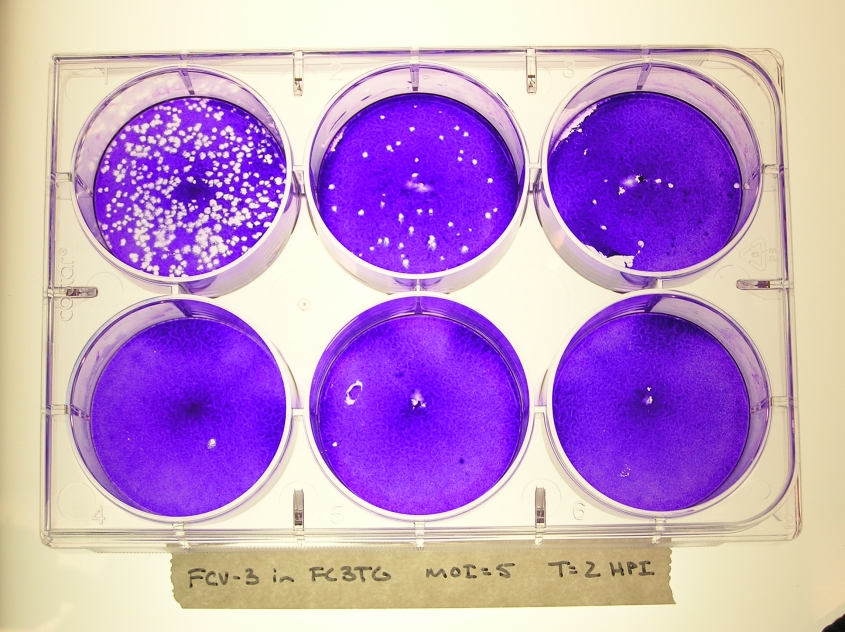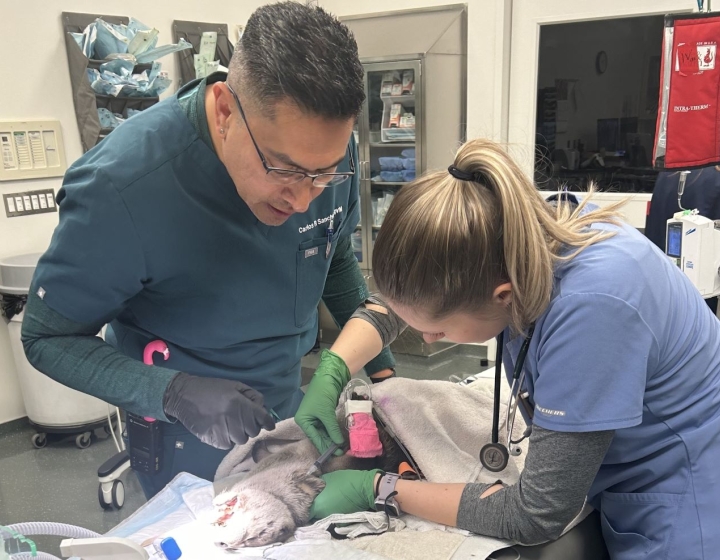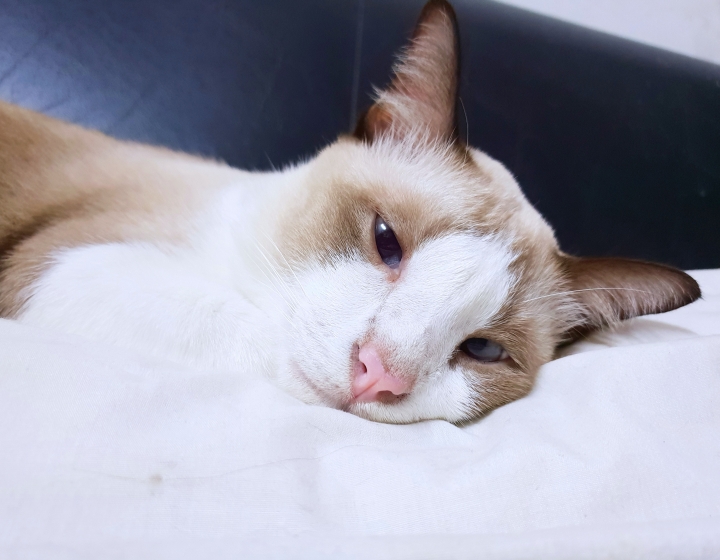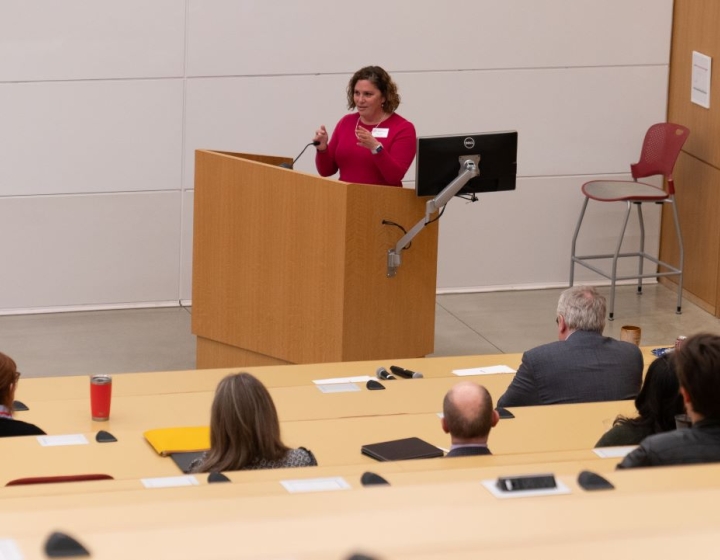Information Breakdown: Feline Calicivirus
Note: This news item features content from another page. View the featured content for this news item.
Feline Calicivirus
Feline calicivirus is a highly contagious virus that causes a mild to severe respiratory infection and oral disease in cats. It is especially common in shelters and breeding colonies, and often infects young cats. Most cats recover completely after a calicivirus infection, but rare strains can be especially deadly. The virus poses no threat to humans.
Cause
Symptoms and complications
Tests and diagnosis
Treatment
Prevention
Additional resources
Baker Institute and calicivirus
Cause
What causes calicivirus infection?
Feline calicivirus (FCV) belongs to a large family of viruses named Caliciviridae, whose members infect a wide range of vertebrate animals, including rabbits, livestock, reptiles, birds and amphibians. The human virus norovirus, which causes a brief but unpleasant gastrointestinal disease, is also a member of the Caliciviridae family.
Several strains of FCV circulate in domestic and wild cats. The virus mutates readily, leading to new strains that may not be fully covered by existing vaccines. Strains vary in the severity of the disease that they cause, with the majority causing only mild disease. The ability of the virus to mutate likely explains why after 40 years of vaccinating against FCV, outbreaks still frequently occur.
Rarely, a mutant strain of FCV will spontaneously arise that causes very serious disease with multiple organ damage or even death, called FCV-associated virulent systemic disease or FCV-VSD. The first known outbreak of FCV-VSD occurred in Northern California in 1998. Outbreaks of FCV-VSD are unusual and unrelated to each other.
Why and how might my cat become infected?
FCV occurs most commonly in multi-cat environments. A cat’s risk of exposure is higher in shelters, pet stores, and catteries, where 25 to 40 percent of cats may be carriers.
The virus spreads through direct contact with the saliva, nasal mucus and eye discharge of infected cats and through aerosol droplets that spread when cats sneeze. Lab tests have also detected the virus in urine, feces and blood. Cats typically shed the virus for about two or three weeks after infection, but some cats become long-term carriers, and continue to shed the virus on and off for months.
FCV is a hardy virus that survives on surfaces for up to a month in certain environments. Humans that handle infected cats can inadvertently transfer the virus to new animals. Objects that come in contact with a cat’s bodily fluids, such as food bowls, litter boxes or bedding, can also be a source of infection.
What happens during infection?
After being exposed to FCV, the incubation period is two to 14 days before symptoms appear. The virus likely initially infects the lining of the back of the mouth. After the virus replicates there, it likely spreads through the bloodstream to other organs. However, FCV preferentially infects the lining of the mouth and the tissues within the lungs. Most cats develop an upper respiratory tract infection and in more severe cases, the virus travels into the lungs where it causes pneumonia.
Symptoms and complications
A cat’s symptoms will depend on the strain of FCV it contracts. At first the cat will have symptoms that look like a cold, with sneezing, nasal congestion, fever and sometimes drooling. Large amounts of discharge can come from the eyes and nose. In more severe cases, cats can also develop inflammation and ulcers on the tongue, and the lining of the mouth. Lethargy, mild lameness and lack of appetite may also occur.
These symptoms can persist from five to 10 days in mild cases and up to six weeks in more severe ones. During the course of the illness, opportunistic bacterial infections can also occur. Cats may lose weight, and the infection can also cause abortions in pregnant cats. Most cats recover completely, but some will go on to develop a chronic form of gingivitis that causes thick and inflamed gums, which makes eating painful. Elderly cats and young kittens are more likely to suffer more severe symptoms. Fortunately, it is quite rare for cats to succumb to FCV infection.
Cats that develop FCV-VSD will have much more severe symptoms, including a high fever, swelling of the head and legs, as well as crusting sores and hair loss on the nose, eyes, ears and footpads. The mouth and ears may turn yellowish from liver damage, and there may be bleeding under the skin and in the gastrointestinal tract. FCV-VSD is fatal in up to 60 percent of cats that develop the disease.
Tests and diagnosis
How will my vet diagnose calicivirus?
Pet owners should always bring their cat to see the veterinarian if it shows signs of respiratory disease. FCV causes about half of the respiratory infections that occur in cats, but feline alphaherpesvirus1 (sometimes called feline rhinotracheitis virus) is another common cause and sometimes dual infections occur. The bacterial species Chlamydia felis and Mycoplasma felis also cause respiratory disease, and may complicate FCV infections.
A veterinarian will examine the cat for symptoms. In most cases, there is no need to make a definite diagnosis, as these infections are common and will resolve with supportive treatment. However, if multiple cats are infected or the cats are housed with others, the veterinarian may take swabs from the eyes, nose or mouth. These swabs will be sent to the lab to test for the presence of the virus. Labs can also test tissue or serum samples.
Commercial labs detect the presence of FCV in two ways: by growing the virus in cells in a petri dish, or through reverse transcriptase PCR (RT-PCR), a procedure that detects a segment of genetic material that is specific to calicivirus. Both tests are equally effective, though the RT-PCR test may be more common in some areas, as part of a panel that tests for several organisms that cause respiratory disease.
Test results should be interpreted carefully. Many cats that appear healthy, especially ones recently adopted from a shelter, pet store or breeder, will test positive for the virus due to previous exposure, so a positive result does not necessarily indicate that FCV is the cause of the problem. Recent vaccination with a modified live strain of the virus can also cause a false positive result. Incorrect negative results are more likely if the cat is swabbed more than a week after the start of the infection.
Commercial testing cannot distinguish between mild strains of FCV and the more virulent strains that cause FCV-VSD.
Treatment
What are the treatment options for cats with calicivirus?
Currently there is no treatment to stop the virus, but pet owners can offer supportive care for their cat while its immune system fights the infection. Most cats can recover at home, but severely affected cats may need intensive nursing care.
Keep the nose and eyes of the cat clean and use vaporizers and saline nose drops to help clear the nasal passages. A drug that breaks down mucus, like bromhexine, also can help reduce congestion. Non-steroidal anti-inflammatory drugs can lower the fever and reduce mouth pain, and broad-spectrum antibiotics can be used to treat opportunistic bacterial infections, when necessary.
Cats often lose their appetite and stop eating due to congestion and the sores in their mouths. Owners should provide strong-smelling, soft foods, which can be pureed to make them easier to swallow and heated slightly to increase their odor. If cats have not eaten for more than three days, they may need hospitalization to receive fluids and IV nutrition.
If a cat develops FCV-VSD, it should receive intensive care, which could include IV fluids, antibiotics and other treatments as needed.
Prevention
How do I vaccinate my pet against calicivirus?
Vaccines do not protect against FCV entirely, but they can greatly reduce the severity of the infection if your cat is exposed. Several combination vaccines against FCV, feline herpesvirus type 1 and feline panleukopenia virus (the cause of feline distemper) are available, which can be given nasally or as an injection. The vaccines given nasally contain a modified live form of the virus, while injected vaccines can be modified live viruses or inactivated ones. Cats that receive the nasal vaccine may sneeze for four to seven days after vaccination.
Once kittens reach six to eight weeks of age, they should receive a vaccine every three to four weeks, with the final booster being given after 16 weeks of age. If the cat is already older than 16 weeks, give two doses of the vaccine, three to four weeks apart. Cats should receive boosters every three years, unless they are in a high-risk, multi-cat environment, in which case they should be revaccinated annually. Even cats that have recovered from a calicivirus infection should receive boosters, because they may not be protected against other strains of the virus.
Studies suggest that the nasal form of the vaccine leads to more rapid protection against the virus, which may be helpful in containing outbreaks in shelters.
A vaccine called Calicivax™ is available that includes modified forms of a strain of FCV that causes FCV-VSD, and a typical strain of FCV. This vaccine may offer some protection against outbreaks of FCV-VSD, but since the virulent strains that cause these outbreaks arise from different mutations in less aggressive strains, it is unknown how effective Calicivax™ will be against future outbreaks. Calicivax™ is not part of the set of core vaccines recommended for all cats.
How else can I help prevent the disease?
If you have multiple cats and one or more are being treated for FCV, then you should quarantine the infected animals and clean food and water bowls, the litter box and other items that may be contaminated with the virus. A dilute bleach solution made up of one half cup of bleach per gallon of water is effective at killing the virus. Cleaning solutions that contain phenol, like Lysol, also are effective, but should not be used around cats because they cause irritation and are toxic. Owners may wish to remove other cats from the home during this period to prevent exposure. The virus will die off naturally after one month.
Cats that become carriers will continue to shed the virus in the home, even after they recover from the infection. Owners may need to re-home carrier cats before disinfecting the home to protect the remaining animals from exposure.
Whenever you bring a new cat into the home, it is wise to isolate the animal from other cats in the household for one to two weeks while you watch for signs of disease.
Additional resources
For veterinarians, the Merck Veterinary Manual provides information on calicivirus and other feline respiratory infections. The American Association of Feline Practitioners publishes a detailed fact sheet from their advisory panel.
Baker Institute and calicivirus
Dr. John S.L. Parker, associate professor of virology at the Baker Institute for Animal Health has worked with calicivirus for 15 years. He wants to know why some cats experience a short flu-like illness, while others develop a chronic gingivitis or the more severe life-threatening form of the disease.
Parker’s research group has investigated different strains of the virus that cause outbreaks of FCV-VSD. Studies in his lab have shown that these viruses can’t be identified based on their genetics, but there are detectable differences among the strains when they grow in cells in the lab.
Parker is also looking into the finer details of how FCV gets inside feline cells, where it copies itself using the cell’s machinery. The virus must shape-shift to attach to a receptor molecule on the surface of cells, which allows it to gain entry. By understanding this interaction, Parker hopes to identify an “Achilles heel” that will lead to the development of more effective vaccines.
These investigations into FCV not only give us a better understanding of this common feline infection, but can also help advance the study of similar caliciviruses, such as human norovirus.






